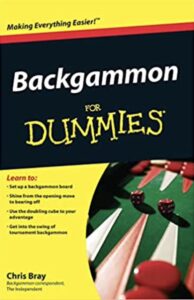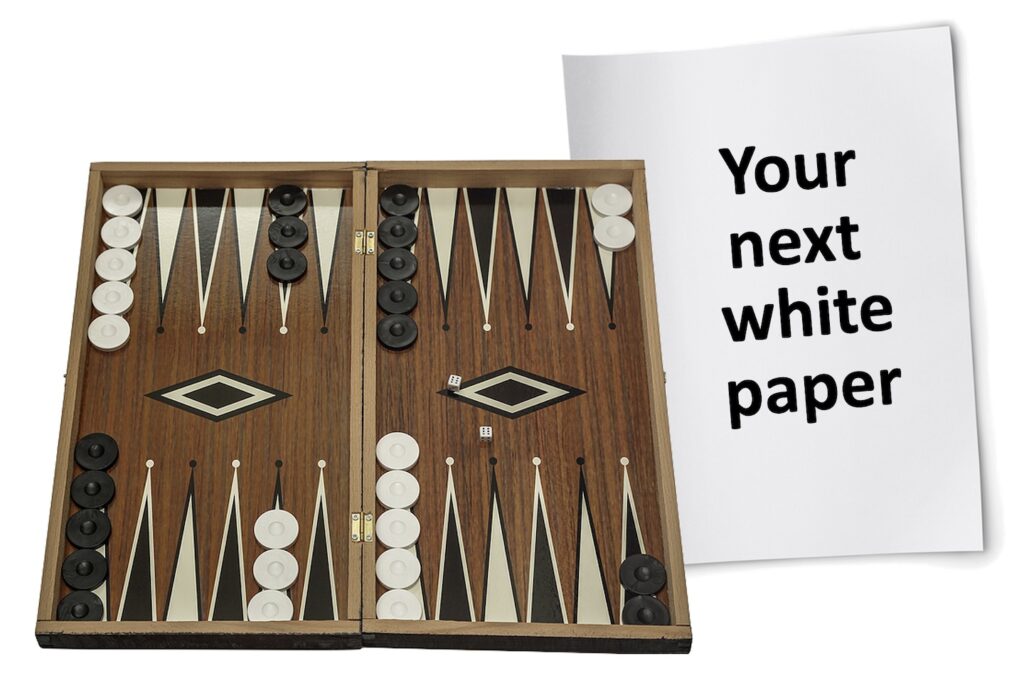
White papers and… backgammon?!
Yes, playing backgammon is a lot like doing a white paper.
If you don’t know what backgammon is, see the intro below.
If you already know the history of backgammon, skip down to “6 similarities between backgammon and white papers.”
Intro: What is backgammon?
Backgammon is an ancient game that dates back at least 5,000 years.
It belongs to the family of “race” or “tables” games that started even earlier, including a version played in ancient Egypt called “Jackals and Hounds.”
That makes it older than chess, older than playing cards, and much, much older than modern board games like Monopoly or Risk.

Jackals and Hounds game board from ancient Egypt
Source: Metropolitan Museum of Art
Today, backgammon is known around the world. And it’s known as the national game of many countries including Egypt, Greece, Israel, Lebanon, and Turkey.
The game is a race where two players each move their 15 pieces around the board, from their distant outposts to their home and then off the board.
To win at backgammon takes a good mix of math, strategy, and luck.
6 similarities between backgammon and white papers
Here are 6 similarities between white papers and backgammon, with some useful tips sprinkled throughout.
Some of these may surprise you!

White papers and backgammon similarities 1:
There are three main types of games
You’ve likely heard my theory of the three flavors of white papers: vanilla, strawberry, and chocolate.
Backgammon also has three main types.
You can play a running game, a hitting game (more offensive), or a blocking game (more defensive).
And each style of game more or less matches a flavor of white paper.
In a running game, you maneuver your pieces past your opponent’s without stopping to engage. This makes for a fast but less exciting game.
This is most like a strawberry white paper: a quick and easy read that doesn’t always make a lasting impression.
In a hitting game, you seize every chance to pounce on any undefended piece. You may end up trading blows with your opponent in a bloody exchange.
It’s thrilling since you sometimes take all-or-nothing risks.
This is like a vanilla white paper that seeks to show how your offering is better than the competition at every turn.
In a blocking game, you try to build up every point in your home base, like red has done in the illustration below.
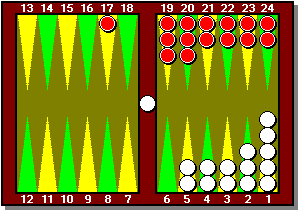 That way, whenever you knock off an opponent’s piece, it cannot re-enter the game because your pieces are in the way. Your opponent has to sit out turn after turn until you start bearing off.
That way, whenever you knock off an opponent’s piece, it cannot re-enter the game because your pieces are in the way. Your opponent has to sit out turn after turn until you start bearing off.
This is very satisfying when you can manage it—and incredibly frustrating for your opponent.
This is like a chocolate-type white paper that seeks to block out the competition by proving that nothing a reader can possibly try will ever solve their nagging business problem. Only your new, improved approach can do that.
Tip: Be clear on which of the three types of white paper you’re using. That will help you know what to put in and what to leave out. For more info, see my infographic.
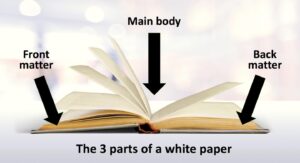
White papers and backgammon similarities 2:
There are three stages to every game
Every white paper has three main parts:
- Front matter at the start
- Main body
- Back matter at the end
Similarly, every backgammon game has three stages:
- Opening
- Middle game
- Bearing off at the end
During the opening, you play your first couple of rolls of the dice and move your pieces from their starting position. These first moves can determine which type of game you’ll play and which side will likely win.
This is a lot like the front matter of a white paper: the cover, table of contents, and executive summary.
The front matter sets the tone and flavor for the whole paper. This is where you get the story moving and “tell them what you’re going to tell them.”
A busy prospect will thank you for including a one-page summary at the start that they can skim in 30 seconds.
After that, they’ll decide whether to invest more time in reading the full-length piece or whether to pass it on to someone else in their organization.
During the middle game, you get down to action and move your pieces right around the board toward your home base.
This is like the main body of a white paper, where you “tell them” the full story, and make your argument from beginning to almost the end.
During bearing off, you systematically remove your pieces from the board. The first person to finish doing that wins the game.
This is like the back matter of a white paper: the conclusions, call-to-action, and information about the company and sources.
This is where you “tell them what you told them” and wrap everything up.
And some people flip right to the back to see “the bottom line.” Your conclusions give them the key takeaways in just a few words.
And if they want to find out more, your call-to-action tells them what to do next.
Tip: A client may say, “But that’s so repetitive! Busy prospects don’t have time to read the same stuff three times over.”
Don’t worry. Repeating your key points is a good thing. Otherwise, why would companies relentlessly replay their ads? Why repeat the positioning statement again and again?
Ask any teacher. Repetition helps the message sink in.
White papers and backgammon similarities 3:
You must be there for the entire journey
In backgammon, you can think of your pieces as the prospects who encounter your white paper. Your challenge is to bring them all home.
That’s rather like drawing a prospect into a customer journey and keeping them engaged all along.
To do this effectively, you have to know which types of content to use during the phases.
If the competition brings home their prospects before you do, they win.
Tip: To engage new prospects at the start of a customer journey, use a problem/solution (chocolate) white paper.
To engage and re-engage a prospect in the middle of a customer journey, use a numbers list (strawberry) white paper.
And to come out ahead in an evaluation at the end of the customer journey, use a backgrounder (vanilla) white paper.
White papers and backgammon similarities 4:
It’s risky to leave a blot (a weak point)
To make a point in backgammon, you must put two pieces on it.
Leaving a single piece on any point is risky; this state of sitting unprotected is rather poetically called a “blot.”
If your opponent lands on a blot, they kick it off the board.
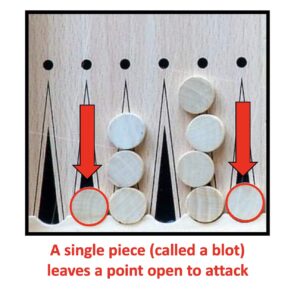
This has a very good analogy in a white paper. To make any point in an argument, you need two things:
- An assertion or claim
- Credible proof to back up that claim
To offer an assertion without proof is risky. Your prospect can easily zero in on that point and think, “Says who?”
Then your whole argument can fall apart.
There’s a corollary too: Including a fact without any context is equally weak.
I’ve seen writers pile on a flurry of facts in a white paper without ever connecting the dots. That just confuses or tires out your readers.
Including an assertion with no proof—or a fact with no context—is as risky as leaving a blot in backgammon.
You can get away with that once in a while, but not as a frequent habit.
If you try it too often, you’ll likely find your arguments knocked right off the board.
Tip: One good approach when you have no proof is to suggest that any reasonable person would agree with your sentiments.
For example: “It’s for the children!”
Who could possibly want to be “against the children?”
If you can come up with a position this hard to attack, you don’t need any proof. But otherwise, you will.

White papers and backgammon similarities 5:
You can be almost home, but get blocked
No game of backgammon is truly over until it’s over. That’s one of the things that makes it so addictive.
You can snatch victory from the jaws of defeat with a lucky roll of the dice.
Or you can be almost home when your opponent sets up a devastating blockade.
How frustrating when your every move is blocked and your every roll unsuccessful!
This is rather like not being able to wrap up a white paper even though you’ve written a draft or two that seemed to sail through the reviews.
Our research shows that this can happen.
In fact, 1 out of every 6 white papers I started were never published, mainly due to project management problems on the client side.
That can be as frustrating as seeing your opponent roll double 6’s twice in a row.
Tip: Get a list of everyone who must approve your white paper in advance, and involve those people from the start:
- Invite them to your kickoff call
- Send them copies of your outline and drafts
- Ask for their comments
All this reduces the odds that a “hidden reviewer” will come out of the woodwork late in the process to block the release of your white paper.

White papers and backgammon similarities 6:
Winning takes strategy, focus, and luck
Winning at backgammon takes a sound strategy, constant focus, and a certain amount of luck.
You need to understand the dynamics of the game, pick an effective strategy, pay attention, never miss any possibilities, and occasionally get lucky with the dice.
That’s a lot like publishing a good white paper.
In terms of strategy, you need to understand the white paper form and gather together the right skills and resources.
Then you must pick an engaging topic, research it in detail, and write up a persuasive document.
In terms of focus, you need to keep your eye on the ball over some weeks to keep the project moving past every delay and obstacle.
And you need a certain amount of luck.
For example, you want your main reviewer to approve your white paper draft before they leave for a three-week silent meditation in Tibet.
And you don’t want some big event—a fire, flood, war, or pandemic—to distract everyone the week your white paper comes out.
Really, you could say that strategy, focus, and luck are three essentials to success in anything.
So there are 6 similarities between backgammon and white papers that I came up with. Did I miss anything?
Feel like learning how to play?
If you’d like to try backgammon, here are a couple of ways to get started:
- Try backgammon software
- Get a simple book with lots of tips

I can often beat the Beginner level in XG Mobile. But Intermediate, not so much.
The best backgammon software
Computer scientists have been all over the game for decades.
Today, XG Mobile is recognized as the best backgammon software in the world.
There’s a free version you can try on your phone. If you like it, it’s only $10 for the ad-free version.
XG can really help you learn how to play. For any spin, it can show you every possible move for each of your pieces, and even suggest your best move.
The app uses a neural network trained by playing millions of games. So it just keeps getting smarter.
I first learned how to play backgammon when I was 7, and I’ve played some cutthroat competitors.
But XG is something else. Playing it has increased my skill tremendously.
I can usually beat the Beginner level, but Intermediate is truly formidable.
A good backgammon book
There are many books on backgammon.
Here’s a good one I’m reading, which manages to explain the game to beginners while still offering tips to experienced players.
Backgammon for Dummies uses a simple, logical approach with lots of pictures of moves on the board.
It’s simple enough for a child, yet profound enough for someone like me who’s played the game for 50+ years.
This book covers all the basics:
• How to set up the board
• The best plays for all 15 opening rolls
• Using the doubling cube
• Strategies for each stage of the game
If you’re wondering about getting a book on backgammon, start with this one. It’s only $15 new, and less for a used copy.
If you decide to learn the game, I wish you many happy games of backgammon!
What do you think? Do backgammon and white papers naturally belong together? Or are they as different as hounds and jackals? Please leave your comment below.


